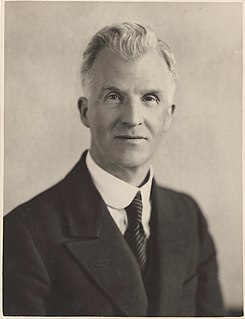
The prime minister of Australia is the head of government of the Commonwealth of Australia. The prime minister heads the executive branch of the federal government of Australia and is also accountable to federal parliament under the principles of responsible government. Anthony Albanese of the Labor Party became prime minister on 23 May 2022.

The United Australia Party (UAP) was an Australian political party that was founded in 1931 and dissolved in 1945. The party won four federal elections in that time, usually governing in coalition with the Country Party. It provided two prime ministers: Joseph Lyons (1932–1939) and Robert Menzies (1939–1941).

Francis Michael Forde was an Australian politician who served as prime minister of Australia from 6 to 13 July 1945. He was the deputy leader of the Australian Labor Party (ALP) from 1932 to 1946. He served as prime minister in a caretaker capacity after the death of John Curtin, and is the shortest-serving prime minister in Australia's history.

James Henry Scullin was an Australian Labor Party politician and the ninth Prime Minister of Australia. Scullin led Labor to government at the 1929 Australian federal election. He was the first Catholic, as well as Irish-Australian, to serve as Prime Minister of Australia. The Wall Street Crash of 1929 transpired just two days after his swearing in, which would herald the beginning of the Great Depression in Australia. Scullin's administration would soon be overwhelmed by the economic crisis, with interpersonal and policy disagreements causing a three-way split of his party that would bring down the government in late 1931. Despite his chaotic term of office, Scullin remained a leading figure in the Labor movement throughout his lifetime, and served as an éminence grise in various capacities for the party until his retirement in 1949.

Simon Findlay Crean is an Australian politician and trade unionist. He was the Member of Parliament for Hotham from 1990 to 2013, representing the Labor Party, and served as a Cabinet Minister in the Hawke, Keating, Rudd and Gillard Governments. He was the Leader of the Labor Party and Leader of the Opposition from November 2001 to December 2003.

The Lodge is the primary official residence of the Prime Minister of Australia, situated in the national capital Canberra. It is located at 5 Adelaide Avenue in the suburb of Deakin, a short distance away from Parliament House. The Lodge is one of two official prime ministerial residences, the secondary official residence being Kirribilli House in Sydney. The building was completed in 1927 in the Georgian revival style, and has been renovated several times since then. It was not initially intended to be used as a permanent official residence, and several prime ministers have chosen to live elsewhere during their terms in office.

The following is an alphabetical list of articles related to Australia.

The deputy prime minister of Australia is the deputy chief executive and the second highest ranking officer of the government of Australia. The office of deputy prime minister was officially created as a ministerial portfolio in 1968, although the title had been used informally for many years previously. The deputy prime minister is appointed by the governor-general on the advice of the prime minister. When Australia has a Labor government, the deputy leader of the parliamentary party holds the position of deputy prime minister. When Australia has a Coalition government, the Coalition Agreement mandates that all Coalition members support the leader of the Liberal Party becoming prime minister and mandates that the leader of the National Party be selected as deputy prime minister.
The spouse of the prime minister of Australia, or partner of the prime minister of Australia, is generally a high-profile individual who assists the prime minister with ceremonial duties as well as performing various other functions.
The history of Australia since 1945 has seen long periods of economic prosperity and the introduction of an expanded and multi-ethnic immigration program, which has coincided with moves away from Britain in political, social and cultural terms and towards increasing engagement with the United States and Asia.
The Prime Ministers Avenue is a collection of busts of the prime ministers of Australia, located at the Ballarat Botanical Gardens in Ballarat, Victoria. The busts are displayed as bronze portraits mounted on polished granite pedestals. It attracts thousands of visitors annually.
Several surveys of academics and the general public have been conducted to evaluate and rank the performance of the prime ministers of Australia.
The history of the Australian Labor Party has its origins in the Labour parties founded in the 1890s in the Australian colonies prior to federation. Labor tradition ascribes the founding of Queensland Labour to a meeting of striking pastoral workers under a ghost gum tree in Barcaldine, Queensland in 1891. The Balmain, New South Wales branch of the party claims to be the oldest in Australia. Labour as a parliamentary party dates from 1891 in New South Wales and South Australia, 1893 in Queensland, and later in the other colonies.
Labour government or Labor government may refer to:

The Prime Minister's Office (PMO), also known as the Office of the Prime Minister, is the private office of the Prime Minister of Australia that provides political advice and executive support to the Prime Minister. The PMO is led by the Prime Minister's Chief of Staff and or Principal Private Secretary and is composed of party advisers, media specialists, and political strategists. Scholars including Professor Anne Tiernan of Griffith University and Professor James Walter of Monash University have observed the centralisation and expansion of power within the PMO over the past three decades.
This page details numerous records and characteristics of individuals who have held the office of Prime Minister of Australia.









